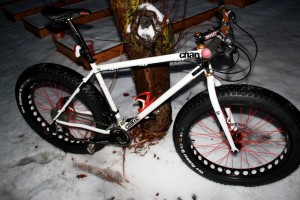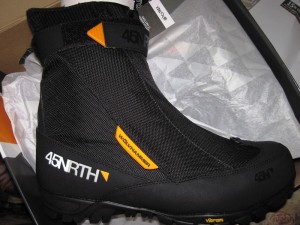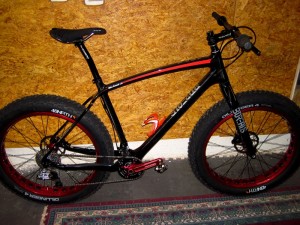As many can attest, I am a fanatic for the single-speed
(SS) bicycle. Over the years I've spent countless hours and miles as well as races aboard my SS bicycles. I've done numerous blog posts about building, racing, riding and reminiscing about my beloved SS bikes. A couple of weeks ago I posted about
single-speed cyclocross (SSCX) conversion techniques. These detailed various simple and economical ways to convert a normal geared bicycle into a single-speed bicycle that met the definition of a single-speed bicycle as defined by USA Cycling. That definition, which can be found on page 30 of the
USA Cycling 2014 Rule Book in Chapter I - General Regulations Section 1I: Bicycles under clause (i);
- A Single Speed is any type of bicycle possessing only one rear cog and only one front chainring and with no means of altering the gear ratio in any way during the race.
 |
| Cassette swapped for cog and spacers |
Pretty simple, right? I think so and as such, wrote a post detailing numerous simple and inexpensive ways to help make any normal cyclocross bicycle conform to the regulations and race legally in the numerous regional USA Cycling sanctioned SSCX events.
In fact, I neglected to mention this alternative before but in terms of the easiest and most cost effective solution to meet the rules would be the following. If you pull the cassette from your rear wheel and exchange it for a
single speed spacer kit and cog you will need to spend $25.99. You could also just scavenge a bunch of cassette spacers from worn out cassettes and use a singe cog from an old cassette, which is what we all did back in the day and cost us nothing. Then, you remove the big ring from the crankset and swap the double chainring bolts for a set of
single chainring bolts which cost $13.99 or use flat washers on the backs of the nuts to space then out a bit. You could also throw a bash ring on instead, which also costs $14 from BBG Bash Rings online. Zip-tie your shifters in place so they mate with the cogs and you are done, and legal. $39.98 and a pair of zip-ties is the cost of converting a legal single-speed. $39.98 is what people were claiming was too high a cost for many to bear, that many could not afford in order to enter a single-speed race. Roughly the cost of a case of premium beer and requiring maybe 20 minutes of time.
Why do I care enough to keep posting guides on how to easily meet the requirements? Because those are the rules, that is the definition and these are billed as single-speed races. I honestly do care about the rules, all of the rules, and I do my very best to abide by those rules at all times. I also care because there are countless disadvantages to a dedicated SSCX bike. For instance, if you skip or chain drop on an SSCX, the chain falls into oblivion not onto another cog or ring. Gear selection onsite is problematic and risky as you have to physically mess with the mechanics of the bike such as the ring or cog used as well as chain tension if not chain length. Not something you want to be doing right before a race, which is why most people
(us included) don't do it. Additionally, with dedicated SS bikes, very, very few people have a spare so there are no pit bikes to speak of. Also, for many folks, their SSCX bike is a secondary piece of equipment and is not as nice or as light as their fancy carbon-fiber geared race bike, despite not having gears. Bottom line, those racing an actual SSCX bike put in the time, effort and expense to build that bike to meet the requirements and moreover, the spirit of the event. I believe that counts for something and should be rewarded, not disincented.
Out of this post came a mostly positive discussion. However, when a follow-on Facebook rant in which I was tagged took over the day's social media discussions, a lengthy diatribe ensued which at first started well but ultimately culminated in vilification of myself and another vocal SSCX purist and proponent by a small group that felt that we were being elitist and trying to undermine the efforts that they had made toward the promotion of the discipline and to the local SSCX series. Not exactly the warm and friendly feeling I'd hoped for when giving my simple, honest opinion by posting a reference to the very clear and concise rules of the competition. Social media persecution for perceived heresy.
I was completely taken aback by this as I've spent as much time as anyone personally promoting the discipline of single-speed cyclocross racing. I've dragged countless individuals into the sport and built, helped to build or consulted in the build of many of the SSCX bikes currently being raced on the circuit. I've written numerous posts on conversion and setup and have been a willing and open resource for single-speed knowledge for all who inquire. I've even offered to help people do their conversions, thrown spare parts from my stash to people to help get them in the game or just built and given dedicated SSCX bikes away.
But a few people didn't see it that way. This left me with a pretty hollow feeling when it comes to the discipline and sport I've spent years trying so hard to promote and build. I take things like this very personally and I also tend to hold grudges. Just can't seem to let it go. I'm not saying that is a good thing, just that it's the way I am. This whole ordeal has weighed heavily on my mind for the past week now. In fact, after the affair transpired I'd decided to quit racing the local SSCX series all together. However, I recanted for the race last weekend given that I had a good friend staying with us whom I'd strong-armed into building up a dedicated SSCX bike and getting in on the fun Saturday in his first SSCX race. Still, I felt awkward and out of place at the event and didn't really want to be there.
Part of the issue is that I have worked hard to build and legitimize the discipline by getting people to take it seriously and by doing my best to recruit talent into the races. I think that right there is where at least some of the rub comes in. When it comes to racing bikes, I take the race itself very seriously. After all, I am paying my
(Cathy's) hard earned money to enter a race and therefore, I am going to give my all every time. However, some people do not treat racing the same way. Moreover, for some reason, they tend to align themselves with the single-speed events. I think that much is this comes from the countless large scale single-speed events that are simply glorified frat parties. As much as I love the single-speed and have had pretty good success at both SSMTB and SSCX, I've shied away from these events for the very reason they are so popular.
Here at our local races I have been a vigilant advocate of the separation of the race and the party. I'm fine with partying and hanging out and having a beer after the race is done but when the race is going on, I want to race and I want people to respect that I and everyone else on the course are racing. Why the need for the sophomoric antics and thinly veiled alcoholic tendencies anyhow? Really, beer feeds and shots before the race? How about keg stands and shotguns or maybe a mid race beer-pong or quarters match or how about buying a breathalyzer and giving bonus points to the racer who blows the highest reading. Wouldn't that be fun, and mature.I'm embellishing of course simply to make a point. When does it stop being a race and start being a party with a $25 cover charge?

I know, I'm taking it too seriously and trying to ruin it. Anyhow, I'm not sure where I'm going from here with the season or with SSCX. I guess that we will just have to see. Trying to keep it positive and I think that I had I not been in the dumps about my form, fitness and results recently this probably would not have bummed me out as much as it did. At present, I feel a commitment to my wife, friends and teammates that I have drawn into the SSCX races. They all spent their time, effort and money to build up bikes with the intent of racing them. Cathy and I also have a big investment, what with our uber-expensive dedicated SSCX bikes that some goob heckled about Saturday
. (Our dedicated SSCX bikes, of which we each have one, were built from all old, used parts that we had and are based on damaged framesets which cost us nothing. They also weigh more than our geared race bikes and sport parts that are inferior to those of our geared race bikes. Sure, they may be nicer than your's but whose fault is that?).
I've been thinking that if I could convince some of the key competition as well as my wife, who is already talking about racing her SSCX in the categorized races next year, it might be fun to enter the 1/2/3 A races on the single-speeds at the smaller venues and just race each other there, for fun. I can say for certain that having so many single-speed races this season meant that I doubled up far too many times, leaving me well over-trained recently. Maybe just racing the single-speed in the A races only would be the best of both worlds, netting all the great competition as well as the fun on the single-speed without cramping the style and flair of the series. After all, I was racing the SSCX now and again in the normal geared races before there was a SSCX series and there isn't a big reason not to do it again I suppose.














